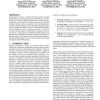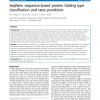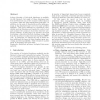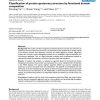25 search results - page 2 / 5 » Relaxation Labeling Processes for Protein Secondary Structur... |
BCB
2010
12 years 11 months ago
2010
In this paper we present a method for flexible protein structure alignment based on elastic shape analysis of backbones, in a manner that can incorporate different characteristics...
ICASSP
2007
IEEE
13 years 11 months ago
2007
IEEE
Protein structure prediction aims to determine the three-dimensional structure of proteins form their amino acid sequences. When a protein does not have similarity (homology) to a...
BMCBI
2010
13 years 4 months ago
2010
Background: Protein folding rate is an important property of a protein. Predicting protein folding rate is useful for understanding protein folding process and guiding protein des...
ADC
2007
Springer
13 years 10 months ago
2007
Springer
A huge diversity of biological databases is available via the Internet, but many of these databases have been developed in an ad hoc manner rather than in accordance with any data...
BMCBI
2006
13 years 4 months ago
2006
Background: The number and the arrangement of subunits that form a protein are referred to as quaternary structure. Quaternary structure is an important protein attribute that is ...




